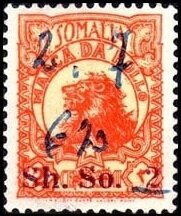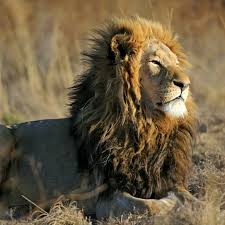Stamp: Lion (Panthera leo) (Somalia 1960)
Lion (Panthera leo) (Somalia 1960)
01 January (Somalia ) within release Revenue goes into circulation Stamp Lion (Panthera leo) face value 2 Somali shilling
| Stamp Lion (Panthera leo) in catalogues | |
|---|---|
| Colnect codes: | Col: SO MB1960-02/03 |
Stamp is square format.
2c stamp of 1950 surcharged "Sh. So. 2" in Italian onlyAlso in the issue Revenue:
- Stamp - Coat of arms face value 1;
- Stamp - Coat of arms face value 0.50;
- Stamp - Coat of arms face value 1;
- Stamp - Coat of arms face value 0.05;
- Stamp - Coat of arms face value 0.10;
- Stamp - Coat of arms face value 0.20;
- Stamp - Coat of arms face value 0.30;
- Stamp - Coat of arms face value 0.50;
- Stamp - Coat of arms face value 1;
- Stamp - Coat of arms face value 2;
- Stamp - Coat of arms face value 3;
- Stamp - Coat of arms face value 5;
- Stamp - Coat of arms face value 20;
- Stamp - Coat of arms face value 50;
- Stamp - Coat of arms face value 60;
- Stamp - Coat of arms face value 100;
- Stamp - Lion (Panthera leo) face value 0.30;
- Stamp - Lion (Panthera leo) face value 50;
- Stamp - Lion (Panthera leo) face value 1;
- Stamp - Lion (Panthera leo) face value 2;
- Stamp - Lion (Panthera leo) face value 0.30;
- Stamp - Lion (Panthera leo) face value 1;
- Stamp - Lion (Panthera leo) face value 2;
- Stamp - Lion (Panthera leo) face value 0.50;
- Stamp - Lion (Panthera leo) face value 4;
- Stamp - Lion (Panthera leo) face value 10;
|
Data entry completed
53%
|
|
|---|---|
| Stamp Lion (Panthera leo) in digits | |
| Country: | Somalia |
| Date: | 1960-01-01 |
| Perforation: | 14 |
| Emission: | Revenue |
| Format: | Stamp |
| Face Value: | 2 Somali shilling |
Stamp Lion (Panthera leo) it reflects the thematic directions:
Animals are multicellular, eukaryotic organisms of the kingdom Animalia (also called Metazoa). All animals are motile, meaning they can move spontaneously and independently, at some point in their lives. Their body plan eventually becomes fixed as they develop, although some undergo a process of metamorphosis later on in their lives. All animals are heterotrophs: they must ingest other organisms or their products for sustenance.
Лев (Panthera leo) — крупный представитель семейства кошачьих рода Panthera, обитающий в странах Африки к югу от Сахары и Индии. У него мускулистое тело с широкой грудью, короткая округлая голова, круглые уши и тёмный пучок волос на кончике хвоста. У него ярко выражен половой диморфизм: взрослые самцы крупнее самок и имеют густую гриву. Это социальный вид, образующий группы, называемые прайдами. Львиный прайд состоит из нескольких взрослых самцов, родственных самок и детёнышей. Группы львиц обычно охотятся вместе, охотясь в основном на средних и крупных копытных. Лев — высший и ключевой хищник.
Mammals are any vertebrates within the class Mammalia (/məˈmeɪli.ə/ from Latin mamma "breast"), a clade of endothermic amniotes distinguished from reptiles (including birds) by the possession of a neocortex (a region of the brain), hair, three middle ear bones and mammary glands. All female mammals nurse their young with milk, secreted from the mammary glands. Mammals include the largest animals on the planet, the great whales. The basic body type is a terrestrial quadruped, but some mammals are adapted for life at sea, in the air, in trees, underground or on two legs. The largest group of mammals, the placentals, have a placenta, which enables the feeding of the fetus during gestation. Mammals range in size from the 30–40 mm (1.2–1.6 in) bumblebee bat to the 30-meter (98 ft) blue whale. With the exception of the five species of monotreme (egg-laying mammals), all modern mammals give birth to live young. Most mammals, including the six most species-rich orders, belong to the placental group. The largest orders are the rodents, bats and Soricomorpha (shrews and allies). The next three biggest orders, depending on the biological classification scheme used, are the Primates (apes and monkeys), the Cetartiodactyla (whales and even-toed ungulates), and the Carnivora (cats, dogs, seals, and allies).
A star is a luminous spheroid of plasma held together by self-gravity. The nearest star to Earth is the Sun. Many other stars are visible to the naked eye at night; their immense distances from Earth make them appear as fixed points of light. The most prominent stars have been categorised into constellations and asterisms, and many of the brightest stars have proper names. Astronomers have assembled star catalogues that identify the known stars and provide standardized stellar designations. The observable universe contains an estimated 1022 to 1024 stars. Only about 4,000 of these stars are visible to the naked eye—all within the Milky Way galaxy.




